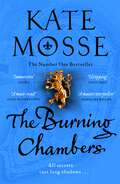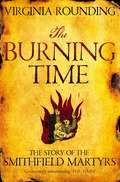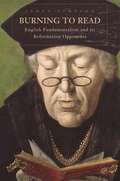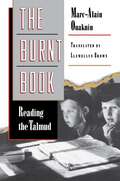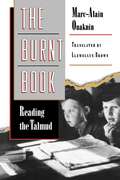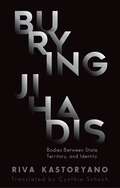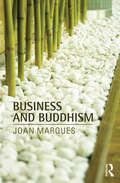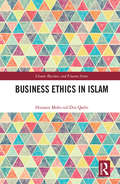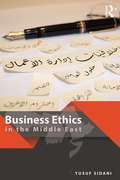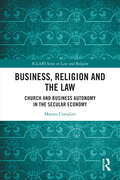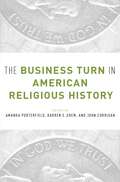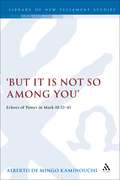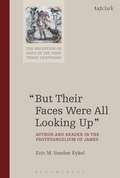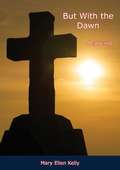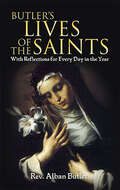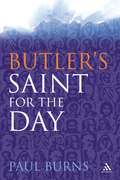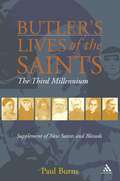- Table View
- List View
The Burning Chambers: the Sunday Times Number One Bestseller (The Burning Chambers #1)
by Kate Mosse* Sunday Times Number One Bestseller *From the multi-million, number one bestselling author of Labyrinth and The Taxidermists Daughter, comes The Burning Chambers: a gripping story of love and betrayal, mysteries and secrets, conspiracies and divided loyalties . . . Carcassonne 1562. Nineteen-year-old Minou Joubert receives an anonymous letter at her father’s bookshop. Sealed with a distinctive family crest, it contains just five words: SHE KNOWS THAT YOU LIVE. But before Minou can decipher the mysterious message, a chance encounter with a young Huguenot convert, Piet Reydon, changes her destiny forever. For Piet has a dangerous mission of his own, and he will need Minou’s help if he is to get out of La Cité alive . . . A thrilling adventure, and a heart-breaking love story, The Burning Chambers is a historical novel of excitement, conspiracy and danger like no other . . .
The Burning Time: The Story of the Smithfield Martyrs
by Virginia RoundingSmithfield, settled on the fringes of Roman London, was once a place of revelry. Jesters and crowds flocked for the medieval St Bartholomew's Day celebrations, tournaments were plentiful and it became the location of London's most famous meat market. Yet in Tudor England, Smithfield had another, more sinister use: the public execution of heretics.Spanning the reigns of British history's most remarkable dynasty, The Burning Time is a vivid insight into an era in which what was orthodoxy one year might be dangerous heresy the next. The first martyrs were Catholics, who cleaved to Rome in defiance of Henry VIII's break with the papacy. But with the accession of Henry's daughter Mary - soon to be nicknamed 'Bloody Mary' - the charge of heresy was levelled against devout Protestants, who chose to burn rather than recant. At the centre of Virginia Rounding's vivid account of this extraordinary period are two very different characters. The first is Richard Rich, Thomas Cromwell's protégé, who, almost uniquely, remained in a position of great power, influence and wealth under three Tudor monarchs, and who helped send many devout men and women to their deaths. The second is John Deane, Rector of St Bartholomew's, who was able, somehow, to navigate the treacherous waters of changing dogma and help others to survive. The Burning Time is their story, but it is also the story of the hundreds of men and women who were put to the fire for their faith. It is a gripping insight into a time when people were willing to die, and to kill, in the name of religion.
Burning to Read: English Fundamentalism and Its Reformation Opponents
by James SimpsonAmid present-day conflagrations, this illuminating book reminds us of the sources, and profound consequences, of Christian fundamentalism in the sixteenth century. Simpson focuses on the cultural transformation in early modern England that allowed common people to read the Bible for the first time. The last wave of fundamentalist reading in the West provoked 150 years of violent upheaval; as we approach a second wave, this powerful book alerts us to our peril.
The Burnt Book: Reading the Talmud
by Marc-Alain OuakninA profound look at what it means for new generations to read and interpret ancient religious texts In this book, rabbi and philosopher Marc-Alain Ouaknin offers a postmodern reading of the Talmud. Combining traditional learning and contemporary thought, Ouaknin dovetails discussions of spirituality and religious practice with such concepts as deconstruction, intertextuality, undecidability, multiple voicing, and eroticism in the Talmud. On a broader level, he establishes a dialogue between Hebrew tradition and the social sciences, which draws, for example, on the works of Lévinas, Blanchot, and Jabès as well as Derrida. The Burnt Book represents the innovative thinking that has come to be associated with a school of French Jewish studies, headed by Lévinas and dedicated to new readings of traditional texts.The Talmud, transcribed in 500 C.E., is shown to be a text that refrains from dogma and instead encourages the exploration of its meanings. A vast compilation of Jewish oral law, the Talmud also contains rabbinical commentaries that touch on everything from astronomy to household life. Examining its literary methods and internal logic, Ouaknin explains how this text allows readers to transcend its authority in that it invites them to interpret, discuss, and recreate their religious tradition. An in-depth treatment of selected texts from the oral law and commentary goes on to provide a model for secular study of the Talmud in light of contemporary philosophical issues.Throughout, the author emphasizes the self-effacing quality of a text whose worth can be measured by the insights that live on in the minds of its interpreters long after they have closed the book. He points out that the burning of the Talmud in anti-Judaic campaigns throughout history has, in fact, been an unwitting act of complicity with Talmudic philosophy and the practice of self-effacement. Ouaknin concludes his discussion with the story of the Hasidic master Rabbi Nahman of Bratslav, who himself burned his life achievement—a work known by his students as "the Burnt Book." This story leaves us with the question, should all books be destroyed in order to give birth to thought and renew meaning?
The Burnt Book: Reading the Talmud
by Marc-Alain OuakninA profound look at what it means for new generations to read and interpret ancient religious texts In this book, rabbi and philosopher Marc-Alain Ouaknin offers a postmodern reading of the Talmud. Combining traditional learning and contemporary thought, Ouaknin dovetails discussions of spirituality and religious practice with such concepts as deconstruction, intertextuality, undecidability, multiple voicing, and eroticism in the Talmud. On a broader level, he establishes a dialogue between Hebrew tradition and the social sciences, which draws, for example, on the works of Lévinas, Blanchot, and Jabès as well as Derrida. The Burnt Book represents the innovative thinking that has come to be associated with a school of French Jewish studies, headed by Lévinas and dedicated to new readings of traditional texts.The Talmud, transcribed in 500 C.E., is shown to be a text that refrains from dogma and instead encourages the exploration of its meanings. A vast compilation of Jewish oral law, the Talmud also contains rabbinical commentaries that touch on everything from astronomy to household life. Examining its literary methods and internal logic, Ouaknin explains how this text allows readers to transcend its authority in that it invites them to interpret, discuss, and recreate their religious tradition. An in-depth treatment of selected texts from the oral law and commentary goes on to provide a model for secular study of the Talmud in light of contemporary philosophical issues.Throughout, the author emphasizes the self-effacing quality of a text whose worth can be measured by the insights that live on in the minds of its interpreters long after they have closed the book. He points out that the burning of the Talmud in anti-Judaic campaigns throughout history has, in fact, been an unwitting act of complicity with Talmudic philosophy and the practice of self-effacement. Ouaknin concludes his discussion with the story of the Hasidic master Rabbi Nahman of Bratslav, who himself burned his life achievement—a work known by his students as "the Burnt Book." This story leaves us with the question, should all books be destroyed in order to give birth to thought and renew meaning?
The Burnt Book: Reading the Talmud
by Marc-Alain Ouaknin Llewellyn BrownIn a profound look at what it means for new generations to read and interpret ancient religious texts, rabbi and philosopher Marc-Alain Ouaknin offers a postmodern reading of the Talmud, one of the first of its kind. Combining traditional learning and contemporary thought, Ouaknin dovetails discussions of spirituality and religious practice with such concepts as deconstruction, intertextuality, undecidability, multiple voicing, and eroticism in the Talmud. On a broader level, he establishes a dialogue between Hebrew tradition and the social sciences, which draws, for example, on the works of Lévinas, Blanchot, and Jabès as well as Derrida. The Burnt Book represents the innovative thinking that has come to be associated with a school of French Jewish studies, headed by Lévinas and dedicated to new readings of traditional texts, which is fast gaining influence in the United States. The Talmud, transcribed in 500 C.E., is shown to be a text that refrains from dogma and instead encourages the exploration of its meanings. A vast compilation of Jewish oral law, the Talmud also contains rabbinical commentaries that touch on everything from astronomy to household life. Examining its literary methods and internal logic, Ouaknin explains how this text allows readers to transcend its authority in that it invites them to interpret, discuss, and re-create their religious tradition. An in-depth treatment of selected texts from the oral law and commentary goes on to provide a model for secular study of the Talmud in light of contemporary philosophical issues. Throughout the author emphasizes the self-effacing quality of a text whose worth can be measured by the insights that live on in the minds of its interpreters long after they have closed the book. He points out that the burning of the Talmud in anti-Judaic campaigns throughout history has, in fact, been an unwitting act of complicity with Talmudic philosophy and the practice of self-effacement. Ouaknin concludes his discussion with the story of the Hasidic master Rabbi Nahman of Bratslav, who himself burned his life achievement--a work known by his students as "the Burnt Book." This story leaves us with the question, should all books be destroyed in order to give birth to thought and renew meaning?
Burying Jihadis: Bodies Between State, Territory, and Identity
by Riva KastoryanoWhat should states do with the bodies of suicide bombers and other jihadists who die while perpetrating terrorist attacks? This original and unsettling book explores the host of ethical and political questions raised by this dilemma, from (non-)legitimization of the 'enemy' and their cause to the non-territorial identity of individuals who identified in life with a global community of believers. Because states do not recognize suicide bombers as enemy combatants, governments must decide individually what to do with their remains. Riva Kastoryano offers a window onto this challenging predicament through the responses of the American, Spanish, British and French governments after the Al-Qaeda suicide attacks in New York, Madrid and London, and Islamic State's attacks on Paris in 2015. Interviewing officials, religious and local leaders and jihadists' families, both in their countries of origin and in the target nations, she has traced the terrorists' travel history, discovering unexpected connections between their itineraries and the handling of their burials. This fascinating book reveals how states' approaches to a seemingly practical issue are closely shaped by territory, culture, globalization and identity.
Burying Jihadis: Bodies Between State, Territory, and Identity
by Riva KastoryanoWhat should states do with the bodies of suicide bombers and other jihadists who die while perpetrating terrorist attacks? This original and unsettling book explores the host of ethical and political questions raised by this dilemma, from (non-)legitimization of the 'enemy' and their cause to the non-territorial identity of individuals who identified in life with a global community of believers. Because states do not recognize suicide bombers as enemy combatants, governments must decide individually what to do with their remains. Riva Kastoryano offers a window onto this challenging predicament through the responses of the American, Spanish, British and French governments after the Al-Qaeda suicide attacks in New York, Madrid and London, and Islamic State's attacks on Paris in 2015. Interviewing officials, religious and local leaders and jihadists' families, both in their countries of origin and in the target nations, she has traced the terrorists' travel history, discovering unexpected connections between their itineraries and the handling of their burials. This fascinating book reveals how states' approaches to a seemingly practical issue are closely shaped by territory, culture, globalization and identity.
Business and Buddhism
by Joan MarquesBusiness and Buddhism explores alternative ways of leading in the aftermath of the Great Recession and the many stories of fraud and greed that emerged. The book explores shifts in business perspectives as more value is placed on soft skills like emotional intelligence and listening, and introduces the reader to the principles in Buddhist philosophy that can be applied in the workplace. Buddhist practices are increasingly understood as spiritual, rather than religious per se. In fact, Buddhism is alternately referred to as a philosophy or psychology. In this book, Marques explores the value of applying the positive psychology of Buddhism to work settings. She outlines the ways in which it offers highly effective solutions to addressing important management and organizational behavior related issues, but also flags up critical areas for caution. For example, Buddhism is non-confrontational, and promotes detachment. How can business leaders negotiate these principles in light of the demands of modern day pressures? The book includes end of chapter questions to promote reflection and critical thinking, and examples of Buddhist leaders in action. It will prove a captivating read for students of organizational behavior, management, leadership, diversity and ethics, as well as business consultants.
Business and Buddhism
by Joan MarquesBusiness and Buddhism explores alternative ways of leading in the aftermath of the Great Recession and the many stories of fraud and greed that emerged. The book explores shifts in business perspectives as more value is placed on soft skills like emotional intelligence and listening, and introduces the reader to the principles in Buddhist philosophy that can be applied in the workplace. Buddhist practices are increasingly understood as spiritual, rather than religious per se. In fact, Buddhism is alternately referred to as a philosophy or psychology. In this book, Marques explores the value of applying the positive psychology of Buddhism to work settings. She outlines the ways in which it offers highly effective solutions to addressing important management and organizational behavior related issues, but also flags up critical areas for caution. For example, Buddhism is non-confrontational, and promotes detachment. How can business leaders negotiate these principles in light of the demands of modern day pressures? The book includes end of chapter questions to promote reflection and critical thinking, and examples of Buddhist leaders in action. It will prove a captivating read for students of organizational behavior, management, leadership, diversity and ethics, as well as business consultants.
Business Ethics in Islam (Islamic Business and Finance Series)
by Hussain Mohi-ud-Din QadriIslamic Business Finance is based on strong ethical regulations as suggested by Islamic Literature, such as the Quran and the Traditions of the Prophet of Islam, and could be considered as a subclass of the wider subject of ethical standards in business. This book highlights the basic principles of Islamic Business ethics and their implication in today’s global business environment. It highlights the most important features of Islamic banking and finance in relation to the core principles of Shariah law. It is the most comprehensive book to date, in terms of the number of Quranic verses and traditions of the Prophet relating to this subject, which are interspersed throughout the text. It explains how ethics are defined both in general terms and within the context of an Islamic perspective. In addition, it provides a logical interpretation of Islamic principles of business ethics, while keeping in view thethrough the use of contemporary business practices. Topics such as digital currencies, money laundering, etc. are discussed at length. This book also discusses the new and emerging ethical issues faced by business and industry globally. This book will be a valuable reference guide for students, teachers and researchers of Islamic banking and finance.
Business Ethics in Islam (Islamic Business and Finance Series)
by Hussain Mohi-ud-Din QadriIslamic Business Finance is based on strong ethical regulations as suggested by Islamic Literature, such as the Quran and the Traditions of the Prophet of Islam, and could be considered as a subclass of the wider subject of ethical standards in business. This book highlights the basic principles of Islamic Business ethics and their implication in today’s global business environment. It highlights the most important features of Islamic banking and finance in relation to the core principles of Shariah law. It is the most comprehensive book to date, in terms of the number of Quranic verses and traditions of the Prophet relating to this subject, which are interspersed throughout the text. It explains how ethics are defined both in general terms and within the context of an Islamic perspective. In addition, it provides a logical interpretation of Islamic principles of business ethics, while keeping in view thethrough the use of contemporary business practices. Topics such as digital currencies, money laundering, etc. are discussed at length. This book also discusses the new and emerging ethical issues faced by business and industry globally. This book will be a valuable reference guide for students, teachers and researchers of Islamic banking and finance.
Business Ethics in the Middle East
by Yusuf SidaniBusiness Ethics in the Middle East fills a crucial gap in the Middle East educational landscape. Written in an easy and accessible format, this book covers the foundations of business ethics by drawing from both Eastern and Western traditions. The chapters include many examples, case studies, activities, and illustrations that are customized to the Middle Eastern market, yet relevant to readers outside of the Middle East who want thorough insights about business behaviour in the region. A special module introduces the Arab Middle Eastern context that non-Arab readers will find valuable. The author addresses topics related to organizational culture, leadership, CSR, corporate governance, marketing, HR, accounting, finance, and production. This is accomplished with a deep attention to the cultural and contextual elements of the Middle East. Special attention is given to religious business ethics, while still deeply engaging the vast heritage of Western ethical systems. This combination is essential for the development of a comprehensive approach to the topic of business ethics. This textbook will be essential reading for students of business ethics in the Middle East and will also be valuable for students and researchers across business ethics, Islamic Studies, religion, and philosophy.
Business Ethics in the Middle East
by Yusuf SidaniBusiness Ethics in the Middle East fills a crucial gap in the Middle East educational landscape. Written in an easy and accessible format, this book covers the foundations of business ethics by drawing from both Eastern and Western traditions. The chapters include many examples, case studies, activities, and illustrations that are customized to the Middle Eastern market, yet relevant to readers outside of the Middle East who want thorough insights about business behaviour in the region. A special module introduces the Arab Middle Eastern context that non-Arab readers will find valuable. The author addresses topics related to organizational culture, leadership, CSR, corporate governance, marketing, HR, accounting, finance, and production. This is accomplished with a deep attention to the cultural and contextual elements of the Middle East. Special attention is given to religious business ethics, while still deeply engaging the vast heritage of Western ethical systems. This combination is essential for the development of a comprehensive approach to the topic of business ethics. This textbook will be essential reading for students of business ethics in the Middle East and will also be valuable for students and researchers across business ethics, Islamic Studies, religion, and philosophy.
Business, Religion and the Law: Church and Business Autonomy in The Secular Economy (ICLARS Series on Law and Religion)
by Matteo CorsaliniThis book investigates the intersection between business and religion from a legal perspective. Taking a fresh look at some of the most compelling literature in law and religion, it proposes a rethinking of what scholars on both sides of the Atlantic have dubbed “church autonomy” or, more recently, “corporate religious freedom”. The volume explores how, in the wake of a decade of US Supreme Court case law, corporate religious freedom is now increasingly being extended to protect the religious liberty of another corporate entity: the for-profit corporation. By exposing this shift from church to business autonomy in American law, it is argued that a similar narrative has also begun to take place in Europe. Through a comparative and interdisciplinary approach to corporate religious freedom, the work provides the reader with a new, comprehensive, and easily accessible history of the genesis and evolution of this legal category in American and European law. The book combines material that straddles international law and religion, corporate law, and economic theory. The diversity of views contained within it makes it a valuable resource for scholars and students in law and religion, corporate social responsibility, and law and economics.
Business, Religion and the Law: Church and Business Autonomy in The Secular Economy (ICLARS Series on Law and Religion)
by Matteo CorsaliniThis book investigates the intersection between business and religion from a legal perspective. Taking a fresh look at some of the most compelling literature in law and religion, it proposes a rethinking of what scholars on both sides of the Atlantic have dubbed “church autonomy” or, more recently, “corporate religious freedom”. The volume explores how, in the wake of a decade of US Supreme Court case law, corporate religious freedom is now increasingly being extended to protect the religious liberty of another corporate entity: the for-profit corporation. By exposing this shift from church to business autonomy in American law, it is argued that a similar narrative has also begun to take place in Europe. Through a comparative and interdisciplinary approach to corporate religious freedom, the work provides the reader with a new, comprehensive, and easily accessible history of the genesis and evolution of this legal category in American and European law. The book combines material that straddles international law and religion, corporate law, and economic theory. The diversity of views contained within it makes it a valuable resource for scholars and students in law and religion, corporate social responsibility, and law and economics.
BUSINESS TURN IN AMERIC RELIG HISTORY C
by Amanda Porterfield, John Corrigan and Darren E. GremBusiness has received little attention in American religious history, although it has profound implications for understanding the sustained popularity and ongoing transformation of religion in the United States. This volume offers a wide ranging exploration of the business aspects of American religious organizations. The authors analyze the financing, production, marketing, and distribution of religious goods and services and the role of wealth and economic organization in sustaining and even shaping worship, charity, philanthropy, institutional growth, and missionary work. Treating religion and business holistically, their essays show that American religious life has always been informed by business practices. Laying the groundwork for further investigation, the authors show how American business has functioned as a domain for achieving religious goals. Indeed they find that religion has historically been more powerful when interwoven with business. Chapters on Mormon enterprise, Jewish philanthropy, Hindu gurus, Native American casinos, and the wedding of business wealth to conservative Catholic social teaching demonstrate the range of new studies stimulated by the business turn in American religious history. Other chapters show how evangelicals joined neo-liberal economic practice and right-wing politics to religious fundamentalism to consolidate wealth and power, and how they developed marketing campaigns and organizational strategies that transformed the American religious landscape. Included are essays exposing the moral compromises religious organizations have made to succeed as centers of wealth and influence, and the religious beliefs that rationalize and justify these compromises. Still others examine the application of business practices as a means of sustaining religious institutions and expanding their reach, and look at controversies over business practices within religious organizations, and the adjustments such organizations have made in response. Together, the essays collected here offer new ways of conceptualizing the interdependence of religion and business in the United States, establishing multiple paths for further study of their intertwined historical development.
The Business Turn in American Religious History
Business has received little attention in American religious history, although it has profound implications for understanding the sustained popularity and ongoing transformation of religion in the United States. This volume offers a wide ranging exploration of the business aspects of American religious organizations. The authors analyze the financing, production, marketing, and distribution of religious goods and services and the role of wealth and economic organization in sustaining and even shaping worship, charity, philanthropy, institutional growth, and missionary work. Treating religion and business holistically, their essays show that American religious life has always been informed by business practices. Laying the groundwork for further investigation, the authors show how American business has functioned as a domain for achieving religious goals. Indeed they find that religion has historically been more powerful when interwoven with business. Chapters on Mormon enterprise, Jewish philanthropy, Hindu gurus, Native American casinos, and the wedding of business wealth to conservative Catholic social teaching demonstrate the range of new studies stimulated by the business turn in American religious history. Other chapters show how evangelicals joined neo-liberal economic practice and right-wing politics to religious fundamentalism to consolidate wealth and power, and how they developed marketing campaigns and organizational strategies that transformed the American religious landscape. Included are essays exposing the moral compromises religious organizations have made to succeed as centers of wealth and influence, and the religious beliefs that rationalize and justify these compromises. Still others examine the application of business practices as a means of sustaining religious institutions and expanding their reach, and look at controversies over business practices within religious organizations, and the adjustments such organizations have made in response. Together, the essays collected here offer new ways of conceptualizing the interdependence of religion and business in the United States, establishing multiple paths for further study of their intertwined historical development.
But It Is Not So Among You: Echoes of Power in Mark 10.32-45 (The Library of New Testament Studies #249)
by Alberto de Mingo KaminouchiPower is an issue that is attracting increased interest among philosophers, theologians and social scientists. The gospel of Mark, especially in 10:32-45, contains teachings attributed to Jesus about the use and abuse of power. This book applies a combination of different methods and approaches: mainly orality, criticism, literary criticism and a sensitivity for the social and cultural environment of the text, showing the centrality of Jesus's message on the issue of power both for the plot and for the theology of Mark. This message is a call to practice leadership in a way that is subversive toward the networks of power of the empire.
"But Their Faces Were All Looking Up": Author and Reader in the Protevangelium of James (The Reception of Jesus in the First Three Centuries #1)
by Eric M. EykelThis study of the Protevangelium of James explores the interrelationship of authors, readers, texts, and meaning. Its central aim is to better understand how the process of repetition gave rise to the narratives of the early Christian movement, and how that process continued to fuel the creativity and imagination of future generations. Divided into three parts, Vanden Eykel addresses first specific episodes in the life of the Virgin, consisting of Mary's childhood in the Jerusalem temple (PJ 7-9), her spinning thread for the temple veil (PJ 10-12), and Jesus' birth in a cave outside Bethlehem (PJ 17-20). The three episodes present a uniform picture of how the reader's discernment of intertexts can generate new layers of meaning, and that these layers may reveal new aspects of the author's meaning, some of which the author may not have anticipated.
"But Their Faces Were All Looking Up": Author and Reader in the Protevangelium of James (The Reception of Jesus in the First Three Centuries #1)
by Eric M. EykelThis study of the Protevangelium of James explores the interrelationship of authors, readers, texts, and meaning. Its central aim is to better understand how the process of repetition gave rise to the narratives of the early Christian movement, and how that process continued to fuel the creativity and imagination of future generations. Divided into three parts, Vanden Eykel addresses first specific episodes in the life of the Virgin, consisting of Mary's childhood in the Jerusalem temple (PJ 7-9), her spinning thread for the temple veil (PJ 10-12), and Jesus' birth in a cave outside Bethlehem (PJ 17-20). The three episodes present a uniform picture of how the reader's discernment of intertexts can generate new layers of meaning, and that these layers may reveal new aspects of the author's meaning, some of which the author may not have anticipated.
But With the Dawn, Rejoicing
by Mary KellyThis is the autobiography of a woman named Mary Ellen Kelly. In her teens she had begun to develop rheumatoid arthritis. By the age of 20 she was almost totally immobile. On a train she couldn’t use the sleeper car, but had to travel in the baggage car, strapped to a board. She had the use of only two fingers on one hand; it once took her over two hours to write a note just twenty-five words long. She had plenty of reason to feel sorry for herself, and indeed she did. In due time, however, she met Fr. Joseph Higgins, a Missionary of Our Lady of La Salette. One day he “read her the riot act,” so to speak, and shocked her into the realization that, especially as a woman of faith, her handicap gave her no excuse to do nothing. She began writing a monthly newsletter called “Seconds Sanctified,” specifically for shut-ins like herself. She had always been a devout Catholic, and now had discovered her place in the Church, encouraging others never to lose faith.Mary Ellen Kelly wrote BUT WITH THE DAWN REJOICING in 1959.
Butler's Lives of the Saints: With Reflections for Every Day in the Year
by Alban ButlerA timeless classic every Christian can appreciate, this volume has been hailed as the authority on Christian saints for more than two centuries. In addition to material in Reverend Butler's original text, this edition includes new saints and those whose feasts are special to the United States.In the text's brief, highly readable entries, readers can find a wealth of knowledge on the lives and deeds of individual saints, as well as their ecclesiastical and historical importance since canonization. Arranged day by day, with cross-indexing for easy reference, the text corresponds to the months of the year and contains entries on saints with feast days in that month.A valuable aid to devotion and a rich source of historical information, Butler's Lives of the Saints, through its concise biographies, remains a helpful and authoritative reference.
Butler's Saint for the Day
by Paul BurnsThis is a new edition of the one volume Butler. Drawn from the original twelve volume work known as Butler's Lives of the Saints, this new edition has selected one principal saint as the focus of attention for each day of the calendar year. And now, for the first time, many saints have been included who were canonised during the Pontificate of Pope John Paul II.
Butler's Saints of the Third Millennium: Butler's Lives of the Saints: Supplementary Volume
by Paul BurnsPope John Paul II has proclaimed an unprecedented number of new saints and blesseds in the 25 years of his pontificate and shows few signs of slowing the process, despite the criticism from at least one cardinal that the altars are getting 'a little crowded'. The proclamations have been made in a large number of countries, from which the new saints and blesseds have come. This reflects a deliberate policy of strengthening the faith of local churches against the threats from totalitarianism, secularism, Pentecostalism, etc. (the Vatican tends to see most of the 'outside' world as a threat). There has also been a deliberate policy to seek more examples of holiness from outside the ranks of clergy and religious. The twentieth century has been seen as the century of martyrs, largely those of Nazism and Communism, and they feature prominently - those of nominally Catholic military regimes are less favoured. The Introduction will make such points. This volume proposes to cover a four-year period in the Butler's style. Blesseds appearing in the 1995-2000 volumes who have since been canonized will have their entries updated and expanded as necessary; new blesseds will be featured with the information that is available - which in the case of some Third-World figures is not very much. Entries will therefore range from around 3,000 words to 200, with an average of some 800. The number of entries will be approximately 80.
